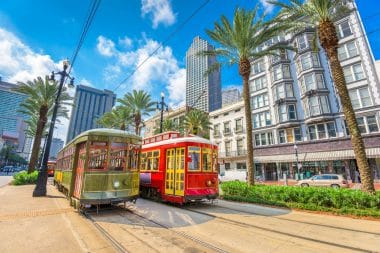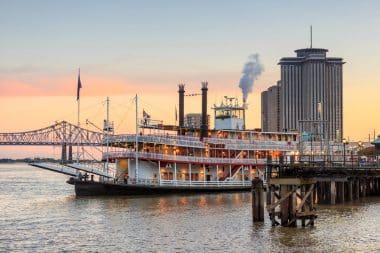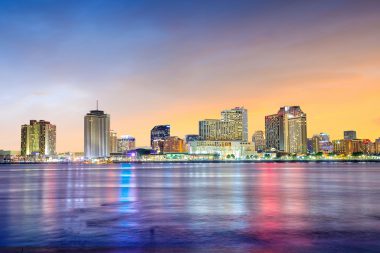New Orleans is located in the south of the US state of Louisiana – where the Mississippi with its masses of water in the Gulf of Mexico created a mighty delta and where Spanish and French colonial rulers found a suitable location for the founding of a port. From here, they were able to open up the American hinterland via the mighty river and at the same time establish a center for the slave trade in the seaport.
During a stroll through the colonial-era French Quarter of the old town or a walk along the banks of the often sung “Old Man River”, you will encounter testimonies of the city’s history at every turn. But it finds its very special expression in the music, which is more atmospheric than anywhere else in the United States above the city.
The French Quarter – nucleus and vibrant center of New Orleans

The founding of New Orleans in 1718 dates back to French colonial rulers. The nucleus of today’s capital of Louisiana is the old town on the banks of the Mississippi River and known as the “French Quarter”. In addition to the river, the French Quarter is bordered by Esplanade Avenue, Canal Street, Basin Street, and Rampart Street. Built in the French colonial style with wonderful cast-iron embellishments, the buildings provide a beautiful backdrop for world-famous Hollywood classics as well as the vibrant life of the city. Films such as Cincinnati Kid or My Name is Nobody with Terence Hill were filmed where visitors to the city now plunge into the nightlife every evening. Hotspots of the vibrant nightlife are also the attractive bars and clubs of Frenchmen Street in the Faubourg Marigny district.
At the former parade ground of the city, Jackson Square, rises the late 18th century. St. Louis Cathedral. The magnificent classicist building is the center of the Archdiocese of New Orleans. An impressive example of Creole architecture can be found on Dumaine Street with the historic ensemble of Madame John’s Legacy. It is listed on the National Register of Historic Places, as is the Old Post Office on Canal Street.
The special events in the Mississippi Delta – When funeral services take a cheerful turn

One of the highlights of New Orleans’ calendar of events is the street carnival, which is celebrated with costume parades around Shrove Tuesday, Mardi Gras Day. Jazz Fest is no less atmospheric. Here, every current jazz great, who is worth his salt, meets in one of the numerous event locations around Bourbon Street.
A tourist attraction are the traditional jazz burials of the dead in the mausoleum-made Cities of Death. After the funeral, marching bands accompanying the funeral societies change the rhythm from sad hymns to cheerful jazz rhythms.
Culinary delights – French specialities with Creole influences and the Café du Monde

The colourful mix of different cultures is also reflected in a diverse gastronomy scene. The French cuisine introduced by the former colonial rulers has been enriched over the centuries by Creole, African and American components. Around Bourbon Street, the density of renowned gourmet restaurants with Creole specialties is particularly high. The menus of the restaurants advertise fish, seafood and lobsters in particular. At the French Market, traders entice visitors with the culinary delights of the region. It is also home to the world-famous Café du Monde, which has become a popular meeting place for tourists thanks to Coffee and Chicory, a coffee speciality consisting of lattes and roasted chicory roots, as well as French pastries.
Paddle steamers and trams – The nostalgia of the modes of transport

A trip on a paddle steamer is one of the absolute must-dos when visiting New Orleans. On the Riverboat, the times of Tom Sawyer come alive and it seems as if Louis Armstrong could enter the stage at any moment to sing about the wonderful world. Every evening, a steam-powered nostalgic ship sets sail for a jazz tour on the Old Man River.
A nostalgic but proven means of transport between the city’s sights are trams. The most famous railway, not least from films, is the St. Charles Line, which consists of green carriages and has been commuting between New Orleans and the suburb of Carrollton since 1893. The Riverfront line, known as the “Ladies in Red”, takes you from the French Quarter to Canal Street.
New Orleans – City of Blues and Jazz
New Orleans has become a melting pot of cultures, not least because of the dark chapter of slavery. Here, blues and jazz have emerged from a mixture of African, Caribbean and European musical elements. In the old town, you will feel reminded at every turn of the great jazz and blues legends who have been part of the city since the beginning of the 20th century. the reputation of the music metropolis of the south.
In the footsteps of jazz and Louis Armstrong
An outstanding personality was Louis Armstrong, who embodied the American dream like no other. The early superstar of jazz music is now one of the tourist figureheads. So you can still walk in the footsteps of the musician today when you stroll through the neighborhoods of Back O’ Town near today’s Mercedes-Benz Superdome or Storyville. In Storyville, which is considered the real cradle of jazz, Armstrong once hired himself out as a coal supplier for brothels. This is where the smoky saloons and honky tonks were located, where jazz was celebrated. The Little Gem Saloon is one of the most authentic places that commemorate those times with live music.
Today, the city’s great son is paid homage through the annual summer festival “Satchmo”. To the north of the French Quarter is Louis Armstrong Park with Congo Square. Since the middle of the 18th century. until the 19th century slaves to make music together. An impressive sign with a larger-than-life bronze statue of the musician is the Perseverance Hall, a former temple of the Freemasons, located in Armstrong Park.
Können wir Ihnen helfen?
Benötigen Sie Unterstützung bei Ihrer Reiseplanung oder weitergehende Informationen zu einzelnen Reisezielen? Wir freuen uns über Ihre Kontaktaufnahme.


